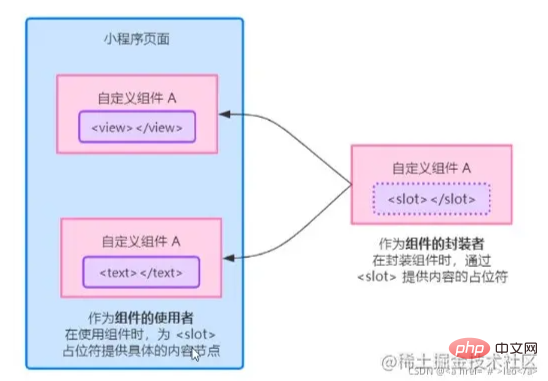
This article will introduce to you the slots in the WeChat applet and several methods of parent-child component communication. I hope it will be helpful to you!

Today we will take a look at the communication between slots and parent-child components in the mini program, and see what the differences are with vue? [Related learning recommendations: 小program development tutorial]
1. What is a slot ?
In the wxml structure of a custom component, a node (slot) can be provided to host the wxml## provided by the component user. # Structure

the sub-component digging the hole and the parent component filling the hole . When the parent component uses the child component, it determines some layout display inside the child component
2. Single slot
In the applet, by default only one is allowed in each custom componentslot Placeholder, this limit on the number is called a single slot
wxml slot, you can declare the enablement<!-- 组件的封装者 --> <view class="wrapper"> <view>这里是组件的内部节点</view> <!-- 对于不确定的内容,可以使用<slot>进行占位,具体的内容由组件的使用者决定 --> <slot></slot> </view> <!-- 组件的使用者 --> <component-tag-name> <!-- 这部分内容将被放置在组件<slot>的位置上 --> <view>这里是插入到组件slot的内容</view> </component-tag-name>
3. Start multiple slots
In the custom component of the applet, when you need to use multiple slots, you can in the .js file of the component
Component({
options: {
multipleSlots: true // 在组件定义时的选项中启用多 slot 支持
},
properties: { /* ... */ },
methods: { /* ... */ }
})4. Define multiple slots
Can be in the component's.wxml Use multiple tags in to distinguish different slots with different name
<!-- 组件模板 --> <view class="wrapper"> <!-- name 为 before 的第一个 slot 插槽 --> <slot name="before"></slot> <view>这是一段固定的文本内容</view> <!-- name 为 after 的第二个 slot 插槽 --> <slot name="after"></slot> </view>
1. Parent-child component communication
JSON compatible data can be set (only data can be passed, methods cannot be passed)
this.selectComponent() so that it can directly access any data and methods of the child component
2. Attribute binding
// 父组件的 data 节点
data: {
count: 0
}
// 父组件的wxml 结构
<my-test3 count="{{count}}"></my-test3>
<view>~~</view>
<view>父组件中,count值为:{{count}}</view>// 子组件的 properties 节点
properties: {
count: Number
}
// 子组件的 wxml 结构
<text>子组件中,count值为:{{count}}</text>3. The core implementation steps of event binding
Event binding is used to realize the transmission from child to parent Value, any type of data can be passed. The usage steps are as follows: of parent component, define a function, which will be passed to the child component in the form of a custom event of the parent component, pass the function reference defined in step 1 to the child component## in the form of a custom event #In subcomponent, by calling this.triggerEvent('custom event name', {/* parameter object*/}), Data is sent to the parent componente.detail4. The core implementation code of event binding
Step 1: In the// 父组件中定义 syncCount 方法
// 将来,这个方法会被传递给子组件,供子组件进行调用
syncCount() {
console.log('syncCount')
},<!-- 使用 bind: 自定义事件名称(推荐:结构清晰) -->
<my-test3 count="{{count}}" bind:sync="syncCount"></my-test3>
<!-- 或在 bind 后面直接协商自定义事件名称 -->
<my-test3 count="{{count}}" bindsync="syncCount"></my-test3>subcomponent, by calling this.triggerEvent('custom event name', {/* parameter object*/}), send data to the parent component// 子组件的wxml结构
<text>子组件中,count值为:{{count}}</text>
<button type="primary" bindtap="addCount">+1</button>
// 子组件中的 js 代码
methods: {
addCount() {
this.setData({
count: this.properties.count + 1
})
this.triggerEvent('sync', {value: this.properties.count})
}
}js 中,通过 e.detail 获取到子组件传递过来的数据代码如下(示例):
syncCount(e) {
// console.log(e.detail.value)
this.setData({
count: e.detail.value
})
}5. 使用 selectComponent 获取组件实例
父组件如何获得子组件实例?
可在父组件里调用 this.selectComponent("id或class选择器"),获取子组件的实例对象,从而直接访问子组件的任意数据和方法。调用时需要传入一个选择器,例如 this.selectComponent(".my-component")
代码如下(示例):
// wxml结构
<my-test3 count="{{count}}" bind:sync="syncCount" class="customA" id="cA"></my-test3>
<button bindtap="getChild">获取子组件实例</button>
getChild() { // 按钮的tap事件处理函数
// 切记下面参数不能传递标签选择器 'my-test3',不然返回的是 null
const child = this.selectComponent('.customA') // 也可以传递 id 选择器 #cA
child.setData({ count: child.properties.count + 1 }) // 调用子组件的 setData 方法
child.addCount() // 调用子组件的 addCount 方法
}更多编程相关知识,请访问:编程入门!!
The above is the detailed content of A brief analysis of several ways of communicating between slots and parent-child components in mini programs. For more information, please follow other related articles on the PHP Chinese website!